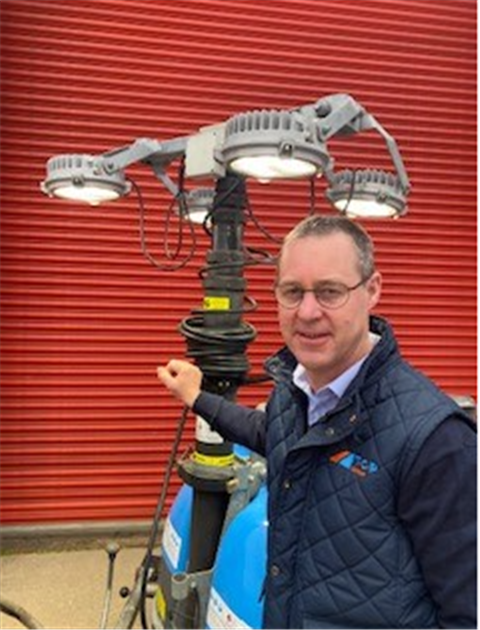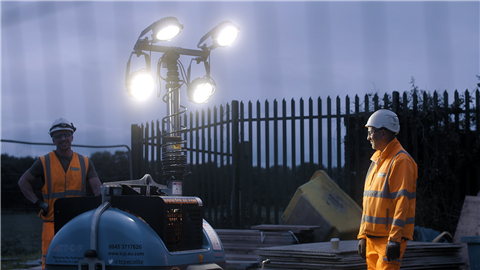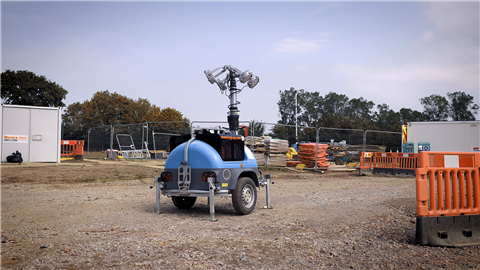Is zero-emission construction machinery practical?
05 September 2021
Andrew Barker, Managing Director of CEA member company TCP Group - a specialist in light-tower manufacturing and compaction equipment - explains how a paradigm shift looks closer now as we move energy vectors away from traditional liquid hydrocarbon fuels to cleaner less polluting alternatives.
 Andrew Barker, Managing Director of CEA member company TCP Group
Andrew Barker, Managing Director of CEA member company TCP Group
One positive outcome from a year of lock down and the personal losses caused by the Covid 19 pandemic, is that the message of ‘build back greener and cleaner’ has moved up the political agenda and looks as though it is beginning to be realised and taken seriously.
While a paradigm shift looks closer now as we move energy vectors away from traditional liquid hydrocarbon fuels to cleaner less polluting alternatives, there are still many things that construction industry contractors, companies and service providers need to consider.
As well as the question ‘what are manufacturers doing to move away from the internal combustion engine (ICE)?’ we need to look more closely at the practicalities of actually using electric and hydrogen powered equipment.
8 Key things companies need to consider before investing in zero-emission construction machinery
-
How will a job site supply the power to recharge a whole fleet overnight?
-
How will the power for recharging be generated – is it by renewable energy?
-
Length of operating time of alternative powered equipment?
-
Effects on power delivery of the equipment?
-
Hydrogen specific – where will the hydrogen be stored on the job site?
-
How will the hydrogen be packaged and be recharged?
-
How green is the source of hydrogen? – i.e. brown, blue or green.
-
When will fuel cell technology be scalable and affordable?
Zero-carbon construction equipment
The first step is to always ask “is zero emission equipment available for the task?” and wherever possible, specify that equipment. Battery and Hydrogen are complementary technologies that are being developed for early adoption to eliminate the ICE in the up to 10kW power range.
 Essex-based, TCP has been in operation for over 30 years and provides light-tower manufacturing and compaction equipment, as well as maintenance and rental services.
Essex-based, TCP has been in operation for over 30 years and provides light-tower manufacturing and compaction equipment, as well as maintenance and rental services.
For many construction and support processes the energy efficiency of the equipment used is under constant review.
There are significant numbers of diesel generators of all sizes that run under load or with low duty cycles, running site compound facilities that in energy efficiency terms look similar to the UKs remaining 1950/60s housing stock!
This has a huge cost in terms of real money and environmental damage which is often overlooked but is fundamental to lowering the power input required.
Much is being addressed in this sector, but a question worth considering is – “does the EPC of the temporary work facility match that of your home?”
Battery powered construction equipment
Battery technology continues to improve in both energy density vs weight and ability to rapid charge, allowing low duty cycle operations to run a full working day with an overnight charge.
Where mains power is available, it is the most cost effective and cleanest fuel to use on any urban site.
Where it is not available, a combination of Hydrogen Fuel cell and local renewables can provide a central ‘charging station’ for overnight use, or together support low duty cycle loads.
The future of hydrogen uses and storage
Hydrogen as an energy vector is an ideal point of use zero emission fuel and has been transported as a compressed gas for many decades, with established safety protocols and working practices that will need wider spread adoption within the Construction sector.
Current working practice is for appropriately sized cylinders to be deployed and exchanged on a timely basis to maintain continuity of service.
 TCP Ecolite TH200 hydrogen fuel-cell powered mobile lighting tower
TCP Ecolite TH200 hydrogen fuel-cell powered mobile lighting tower
As uptake increases and we move up the power bands there will come a time when equipment will have on board hydrogen storage (similar to the technology used in cars and buses today) and be re-fuelled from a mobile system. Much the same as the current diesel bowser.
Equipment using a Hydrogen Fuel Cell as its main source of energy has the ability to provide continuous power with regular H2 refills, in a similar way to Diesel generators today - albeit the efficiencies are much greater when low duty cycles and loads are expected.
A holistic approach is required when looking at the economic argument for this switch, the widespread negative effects of using fossil fuel and diesel, in particular, are well established and not to be ignored. The occupational and societal health benefits of moving away from anything with PM2.5 or NOX as an output is compelling.
Government regularly report on the effects of diesel use and are to be commended for at long last taking the Hydrogen proposition seriously.
Is hydrogen really green?
While much of the hydrogen used today is produced from fossil fuels and is known as blue, brown, black or grey depending on its specific source, green hydrogen is produced by splitting water into its component hydrogen and carbon atoms using electricity - a method called electrolysis.
There are significant moves being made today to develop hydrogen production systems that are run from renewable energy sources.
A number of strategically placed production facilities around the UK will provide the requirements for both larger scale transport and mobility demands but also be a relatively ‘local’ source for infrastructure build requirements.
Is hydrogen cost competitive?
A move to green hydrogen is the ideal for those wanting to innovate and make the shift. This will come with significant investment costs with a short-term increase in direct costs on site.
In the course of time market forces will determine the price of green hydrogen as an energy vector with a new norm set that gives a cleaner environment in which to live, work, and pass on to future generations.
Hydrogen Fuel Cells, alongside Battery technology, have the ability to support large ranges of power requirements and are fully scalable to meet most demands.
The more significant challenge is ensuring that the volume of compressed H2 is available and deliverable to construction sites in a safe, convenient and cost effective manner.
About TCP Group
Based in Maldon, Essex, TCP is a specialist in lighting towers and compaction equipment. It has been pioneering the use of hydrogen since the launch of the Ecolite-TH2 in 2013, some years ahead of the market shift we are now seeing.
The range of Hydrogen, Battery, and PV hybridised products continues to expand, with many applications requiring the need for an energy use study before embarking on a deployment.
TCP has a depth of experience and knowledge to offer their customers in consulting on the energy requirements of an application, delivering the appropriate equipment, and then supporting with a fully managed Hydrogen supply service.
The Ecolite-TH200 is very much the mainstay product for the business, with many machines delivering a CO2 saving in excess of 2000kg/annum at point of use.
STAY CONNECTED



Receive the information you need when you need it through our world-leading magazines, newsletters and daily briefings.
CONNECT WITH THE TEAM







